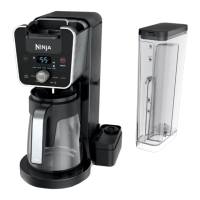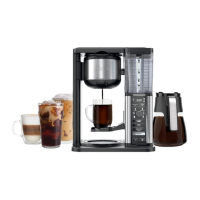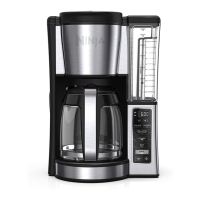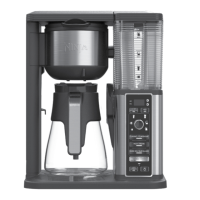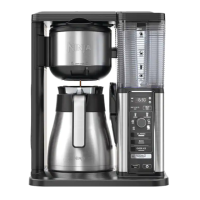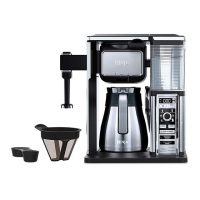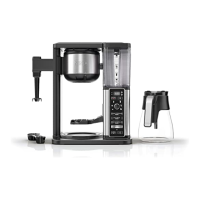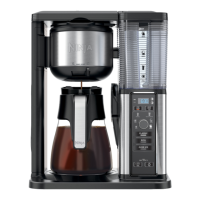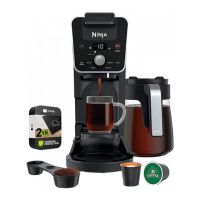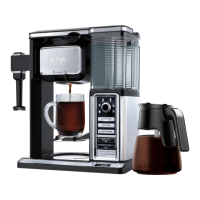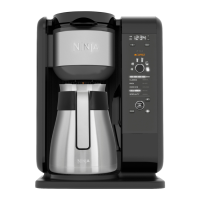ninjakitchen.com
ninjakitchen.com
There’s sediment in my coee.
• This may be due to using finely ground coee. To reduce the amount of sediment in the brewed coee,
use a slightly coarser grind.
• This may be due to using a damaged or old pod.
Over Ice brew is not cold.
• Ensure your cup or travel mug is filled all the way to the top with ice cubes before brewing. Coee
maker will brew at elevated temperatures to lock in the best flavor, then the ice will cool the brewed
coee to the perfect temperature.
Coee is too weak.
• For stronger coee, use the Rich brew setting. For an even bolder flavor, you can add more coee
grounds to the filter. DO NOT exceed the maximum recommended amount of scoops when brewing a
24 oz. coee.
Coee is too strong.
• For milder coee, use the Classic brew setting. For an even milder flavor, use fewer coee grounds in the
filter.
Brew cycle is too slow.
• The brew time will vary based on size and brew style. Larger size brews and Rich brews will take longer
than smaller size brews and Classic brews. The progress bar on the control panel will indicate brew
status.
Cup or travel mug overflowed.
• Refer to the Approximate Brew Volumes chart on page 6.
Brew Basket overflowed.
• The bottom of the brew basket or the nozzle may be clogged. If nozzle is clogged, refer to the
CLEANING THE NOZZLE section on page 10. This can happen with finely ground coee or too many
coee grounds in the filter. Medium-grind coee is recommended.
• Decaf coee grounds absorb water dierently, so use fewer scoops when using decaf.
There is water left in the reservoir.
• When the reservoir is filled to a specific size and then that size is brewed, there will be some water left in
the reservoir. This is normal to ensure the reservoir does not run dry and aect the performance of the
pump and brew system.
Coee maker is leaking.
• After removing the water reservoir, there may be a small amount of water in the reservoir valve. This can
be easily removed with a dry cloth.
• If the leak is coming from above the brew basket, refer to “Brew Basket overflowed.” above.
• If the leak is coming from below the brew basket, lift the coee maker lid to engage the drip stop.
• If the leak is coming from behind the nozzle, refer to "CLEANING THE NOZZLE" section on page 10.
• If the leak is coming from the bottom of the coee maker, call Customer Service at 1-877-646-5288.
Intelligent Clean Cycle Indicator is illuminating orange.
• Run a clean cycle. If you have recently completed a clean cycle, you may need to run another cycle to
remove additional mineral buildup that occurs naturally over time and is common in hard-water areas.
Make sure you are using vinegar or a descaling solution and follow the cleaning instructions.
TROUBLESHOOTING GUIDE
If this appears on your control panel, this means either there are grounds built up inside the top needle
or calcium scale buildup in the brew system.
1 Ensure that the top and bottom of the pod you are using are punctured.
a. If the pod wasn’t punctured, place a new pod in the Ninja Pod Adapter and carefully apply pressure
on the pod until the bottom of the pod is punctured by the bottom needle and then close the
coee maker lid.
b. If the new pod wasn't punctured, please contact Customer Service for assistance.
c. If the pod was punctured, go to step 2.
2 Check if there are any visible grounds inside the top and bottom needles.
a. If there are grounds visible in the top or bottom needle, use a flat wire or plastic clip, such as a
paper clip, to clean the grounds out of the needle.
b. After cleaning out the needle, restart the system by powering o the coee maker, turn it back on,
and run a water-only 12 oz. brew to clear the system.
c. If there are no grounds present, go to Step 3.
3 There may be calcium scale buildup in the brew system and a clean cycle needs to be run immediately
to remove the buildup. See ‘Cleaning & Descaling Your Brewing System’ for instructions.
Coee Maker Buildup
TROUBLESHOOTING GUIDE CONT.
10 11
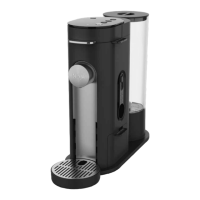
